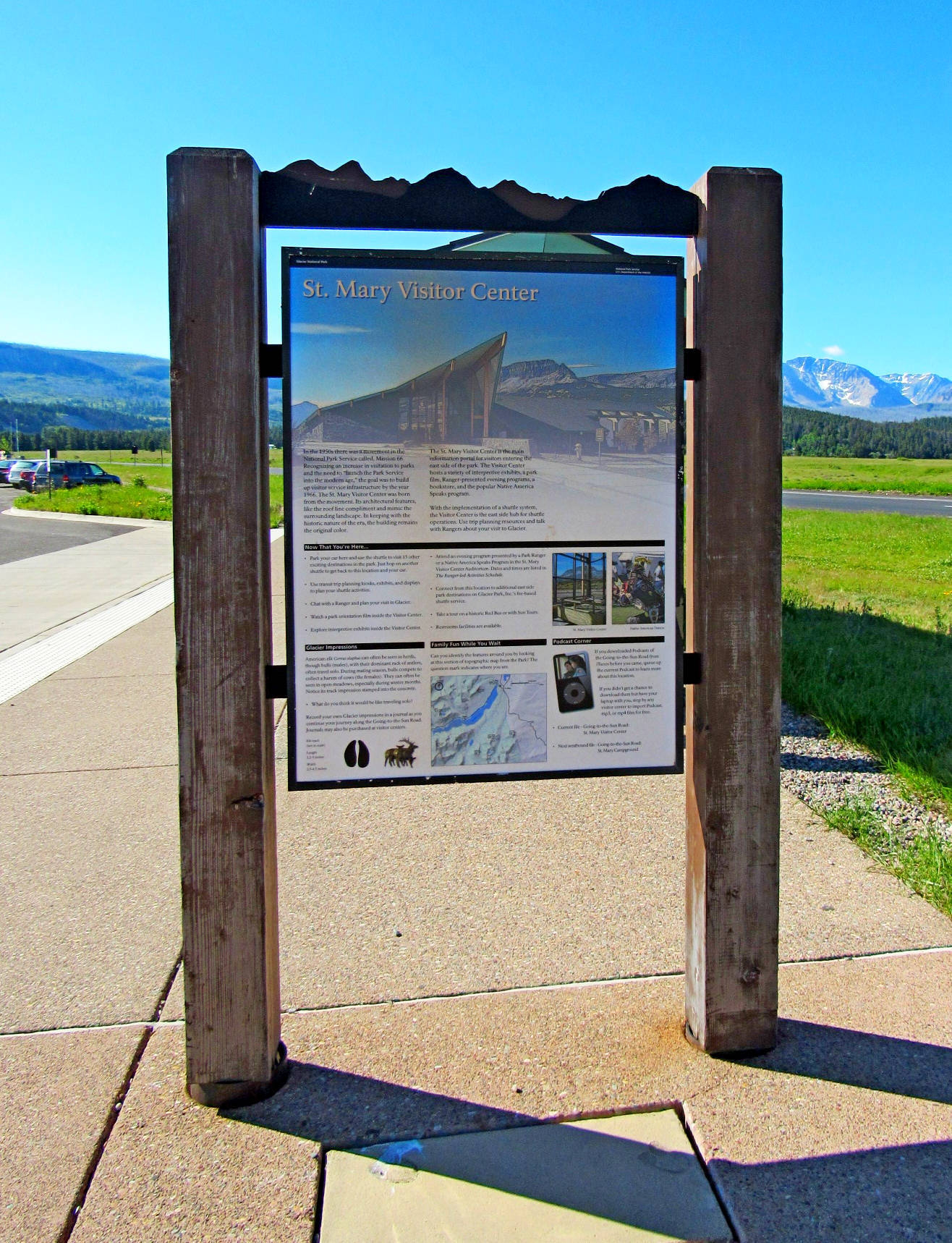Upon entering Glacier National Park at the St. Mary (East) entrance, the first landmark encountered is the Visitor Centre and the park gates. Most first timers will pull into the parking lot behind the visitor centre, which is immediately north of the park gates, get out of their vehicle and head into the centre. On the way they will quite likely pass a multitude of informational signs revealing the story of Glacier National Park.
This particular sign has, at its foot, the hoof prints of an American Elk. The shallow hoof prints are in a small piece of concrete placed within the concrete sidewalk leading north to the visitor centre. Possibly the park staff poured a small rectangle of concrete, then coaxed an Elk into walking across it, thereby leaving his signature. Perhaps, while pouring sidewalks in the park, an Elk happened to walk over the newly poured concrete. Who knows?!?! In any event, we have a pair of very shallow Elk hoof prints displayed in front of the sign which relays a bit of the story of local elk herds and of the visitor centre itself.

Below is text from said sign.
Glacier Impressions
American elk Cervus elaphus can often be seen in herds, though bulls (males), with their dominant rack of antlers, often travel solo. During mating season, bulls compete to collect a harem of cows (the females). They can often be seen in open meadows, especially during winter months. Notice its track impression stamped into the concrete.
• What do you think it would be like traveling solo?
St. Mary Visitor Center
In the 1950s there was a movement in the National Park Service called, Mission 66. Recognizing an increase in visitation to parks and the need to "launch the Park Service into the modern age," the goal was to build up visitor service infrastructure by the year 1966. The St. Mary Visitor Center was born from the movement. Its architectural features, like the roof line compliment and mimic the surrounding landscape. In keeping with the historic nature of the era, the building remains the original color.
The St. Mary Visitor Center is the main information portal for visitors entering the east side of the park. The Visitor Center hosts a variety of interpretive exhibits, a park film, Ranger-presented evening programs, a bookstore, and the popular Native America Speaks program.
With the implementation of a shuttle system, the Visitor Center is the east side hub for shuttle operations. Use trip planning resources and talk with Rangers about your visit to Glacier.
From a large plaque near the visitor centre entrance
Further below are several more views of Glacier National Park. Enjoy!! 😊
A showcase of melting glaciers, alpine meadows, carved valleys, and spectacular lakes. With over 700 miles of trails, Glacier is a paradise for adventurous visitors seeking wilderness steeped in human history. Relive the days of old through historic chalets, lodges, and the famous Going-to-the-Sun Road.
Glacier National Park was established as a park on May 11, 1910, as Waterton-Glacier International Peace Park in 1932, as an International Biosphere Reserve in 1974 and as Waterton-Glacier International Peace Park World Heritage Site in 1995. Its International Peace Park partner, Waterton Lakes National Park was established in 1895.
The world's first "international peace park," the combined site encompasses breathtaking snowcapped mountains, high-altitude lakes, and rivers cascading from glaciers. Glacial landforms, preserved fossil assemblages, breathtaking rock formations and other geological features provide outstanding aesthetic beauty. Ancient cedar-hemlock forests, alpine tundra, and extensive bunchgrass prairie provide diverse natural habitats for over 300 terrestrial species of animals. These mountains are home to a number of threatened or endangered species including the grizzly bear, gray wolf, lynx, bald eagle, and peregrine falcon.
Waterton-Glacier's distinctive climate, its interface between mountain and prairie ecosystems, and its three separate watersheds, all help to create a rich diversity of flora and fauna that is particularly impressive given the relatively small area included in the parks. Straddling the international border, Waterton-Glacier symbolizes goodwill and cooperation between Canada and the United States. Referred to as the Crown of the Continent, this area is home to one of the world’s most remarkable and unique natural environments.
In addition to its natural beauty, the parks have a long and rich history for the area’s native populations. American Indians have lived in and used these mountains for over 10,000 years and this long occupation continues to the present day. The Blackfeet Indians and their closely related tribes north of the border occupy traditional lands east of the park boundaries. On the western site, Kootenai and Salish Indian tribes. To this day, all of the nearby tribes look to the mountains as sacred areas and continue to visit them for reasons both traditional and ceremonial.
From Glacier National Park